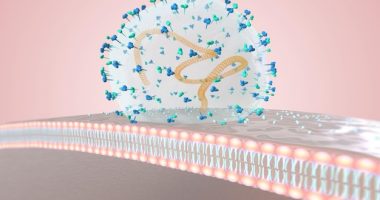Humans and animals alike depend on well-coordinated locomotion to navigate their environments, but the brain mechanisms underpinning this essential movement are not entirely understood. Traditionally, the subthalamic nucleus (STN), a small but significant component of the basal ganglia, has been thought to act as a suppressor of movement. Previous studies have found that damaging or inhibiting the STN leads to increased movement vigor, while exciting it produces the opposite effect. Yet intriguingly, scientists have observed that the STN frequently shows upticks in activity during movement. A paradox thus exists in our understanding of the STN’s function relative to physical locomotion.
Enter the groundbreaking research led by Joshua W Callahan and his team, which offers new insights into this complex neurobiological narrative. Their study, titled “Movement-related increases in subthalamic activity optimize locomotion,” delves into how the STN’s activity correlates with motion, especially locomotion, by studying its behavior in mice both at rest and during self-initiated, self-paced movement on a treadmill. The team’s findings reveal that most STN neurons ramp up their activity during movement and are particularly active during the propulsive phase of walking. Importantly, inhibiting these neurons in the lateral STN disrupts and shortens locomotion, highlighting their crucial role. Moreover, in Huntington’s disease mice, characterized by impaired movement, these neurons show reduced activity, further underscoring their importance in facilitating normal movement. The research not only challenges the traditional view of the STN but also opens potential therapeutic avenues for movement disorders.
The human brain is a complex network where multiple regions interact to enable everything from basic survival processes to advanced cognitive functions. Among these regions, the basal ganglia stand out for their critical role in a variety of motor and non-motor functions. Traditionally, these structures have been intimately associated with the regulation of movement, as well as learning, emotion, and even addictive behaviors. One key but often understated component of the basal ganglia is the subthalamic nucleus (STN).
Historically, the STN has been characterized primarily as a suppressive force in the modulation of movement. This notion underpins its pivotal role in therapeutic interventions like deep brain stimulation (DBS) for Parkinson’s disease, where it helps alleviate motor symptoms by modulating neural activity. The classical understanding posits that the STN sends inhibitory signals that help prevent excessive or unwanted movements. Consequently, neurologists and neuroscientists have focused on either suppressing or enhancing its activity to balance the motor functions in various clinical scenarios.
However, the simplicity of this traditional view has been increasingly challenged by contradictory evidence. While the suppressive role of the STN is well-documented, more recent studies have shown heightened activity in the STN during movement. This counterintuitive observation suggests that the STN’s role in movement might be more nuanced than previously thought, potentially acting not only as a brake but also as a facilitator under certain physiological conditions.
In light of these developments, the research by Joshua W Callahan and his team gains profound significance. Their study uses cutting-edge techniques in neuroscience to provide empirically backed insights into the STN’s role during actual movement phases. By studying STN activity in live animals during controlled locomotion tasks, they have begun to unravel the complexities of this brain region in ways that were not previously possible. The research not only contributes to a better understanding of the basic science underlying motor control but also promises to refine therapeutic strategies for movement disorders, particularly those where the STN plays a crucial role, such as in Parkinson’s disease and Huntington’s disease.
The study’s significance is underscored by the high prevalence and the debilitating nature of motor function disorders. With Parkinson’s disease alone affecting millions worldwide, and Huntington’s disease causing severe neurological degeneration, the potential to improve quality of life through targeted brain therapies highlights the profound impact such research can have. By shifting the paradigm of how the STN is viewed from merely an inhibitor to a more dynamic role in motor control, this research opens up new avenues for medical interventions which could be more effective and less invasive than current treatments like surgical DBS.
Considering this context, Callahan’s research provides not just academic curiosity but a beacon of hope for improving therapeutic methodologies. This exploration of the STN’s neurobiological mechanisms during movement is a critical step forward in the intricate dance of science and medicine aimed at harnessing the brain’s own capabilities to treat and heal.
To delve deeply into the nuanced role of the subthalamic nucleus (STN) in locomotion, Joshua W. Callahan and his team employed a combination of sophisticated experimental techniques, primarily utilizing mouse models to bridge our understanding of neural circuits and behavioral outcomes. The meticulous methodological approach they adopted involved several key components, each designed to tease apart the complex interplay of neural activity and movement.
**1. Animal Preparation and Selection:**
The team used genetically modified mice, including both normal and Huntington’s disease models, which provided a means to investigate the STN’s role in both typical and pathological conditions. This choice allowed for a direct comparison of STN activity between normal motor function and motor-impaired states induced by neurological disorders.
**2. Implantation of Neural Recorders:**
A critical component of the study was the implantation of microelectrodes in the STN. The researchers used precise surgical techniques to implant these devices, which were capable of recording neuronal activity in real-time. This setup was crucial for monitoring how neuronal firing patterns changed in response to, or in anticipation of, movement.
**3. Treadmill Locomotion Setup:**
To examine self-initiated, self-paced movement, mice were placed on a specially designed treadmill equipped with sensors to detect and record various parameters of movement. The treadmill allowed the animals to move freely at their own pace, thereby mimicking natural locomotion, which is essential for evaluating the STN’s role under normal physiological conditions.
**4. Neural Activity Recording and Analysis:**
During the locomotion tasks, neural activity from the STN was recorded concurrently. Advanced signal processing tools were employed to analyze the firing rates and patterns of STN neurons. The team particularly focused on identifying changes in activity during different phases of movement, such as initiation, propulsion, and termination.
**5. Optogenetic Manipulation:**
An innovative aspect of the methodology was the use of optogenetics, a technique that enables the control of neuronal activity with light. By genetically modifying specific neurons in the STN to express light-sensitive ion channels, the researchers could selectively inhibit or excite these neurons during various phases of movement. This approach was critical for determining the causal relationships between STN activity and locomotor behavior.
**6. Behavioral Assessments:**
Behavioral outcomes were meticulously recorded and analyzed to assess the impact of manipulating STN activity on locomotion. Various metrics, such as stride length, speed, and frequency of steps, were measured to evaluate the quality and characteristics of movement.
**7. Data Integration and Computational Modeling:**
Finally, the collected data were integrated into a computational model to simulate how modifications in STN activity might affect overall motor control and behavior. This modeling helped to predict the effects of potential therapeutic interventions aimed at modulating STN activity in human patients.
By combining these diverse yet complementary approaches, Callahan’s study offers a comprehensive examination of the STN’s role in motor control. The methodology not only provides direct insights into the fundamental brain mechanisms underlying locomotion but also establishes a framework for developing more effective treatments for movement disorders such as Parkinson’s disease and Huntington’s disease. The research, with its blend of cutting-edge neuroscience techniques, paves the way for future studies exploring the intricate dynamics of the basal ganglia and their contribution to coordinated movement.
**Key Findings and Results**
The study led by Joshua W. Callahan offered groundbreaking findings, fundamentally shifting our understanding of the subthalamic nucleus (STN) and its role in locomotion. Here is an in-depth look at the key results from their rigorous experimental framework:
**1. STN Neuronal Activity Increases with Movement:**
One of the study’s primary discoveries was that neuronal activity in the STN significantly increases during movement. This was especially noteworthy during the propulsive phases of walking, where the neurons displayed heightened firing rates. This observation is counterintuitive to the traditional view which primarily considered the STN as a suppressive modulator of movement. Instead, these results suggested that the STN might be actively involved in facilitating and optimizing locomotion.
**2. Role of Lateral STN Neurons in Sustaining Locomotion:**
A critical finding from the use of optogenetic inhibition was the crucial role played by neurons in the lateral part of the STN in sustaining locomotion. When these neurons were inhibited, there was a noticeable disruption in locomotion, which included a reduction in the length and speed of strides. This indicates that the lateral STN has an essential facilitatory role in the control of movement, contributing dynamically to the modulation of walking and potentially other forms of movement.
**3. Huntington’s Disease Models Show Altered STN Activity:**
In models of Huntington’s disease, the STN neurons showed a markedly different pattern of activity compared to healthy controls. Particularly, there was a significant reduction in the activity during movement phases. This alteration suggests that the observed motor deficits in Huntington’s disease might be partly due to the diminished facilitatory role of the STN, offering a potential new target for therapeutic interventions.
**4. Optogenetic Manipulation Reveals Causal Relationships:**
The application of optogenetics proved essential for establishing a direct causal link between STN activity and movement efficacy. By selectively activating or inhibiting these neurons, the study was able to demonstrate that STN activity directly influences locomotion effectiveness. This causal connection opens up new avenues for therapeutic approaches that could involve precise modulation of STN activity to restore or enhance motor function.
**5. Computational Modeling Aligns with Experimental Data:**
The computational models developed to simulate STN activity provided a robust framework for predicting the effects of neural modulation on motor control. These models aligned closely with the experimental data, reinforcing the validity of the findings. They showed how specific changes in STN activity could potentially be manipulated to correct or compensate for dysfunctional movement patterns seen in diseases like Parkinson’s and Huntington’s.
Through these findings, Callahan and his team’s study not only challenged the existing paradigms about the STN but also highlighted its complex, dualistic role in both inhibiting and facilitating movement. This nuanced understanding presents a more dynamic view of how movement is regulated in the brain and offers new, targeted strategies for managing movement disorders. The research underscores the potential of neuro-modulation therapies that specifically target the STN, providing hope for more effective treatments that leverage the brain’s intrinsic mechanisms for better motor control and improved quality of life for patients with motor function disorders.
The groundbreaking findings presented by Joshua W. Callahan and his team pioneer a re-invigorated dialogue on the neurobiological underpinnings of movement, marking a significant departure from conventional understandings that limited the subthalamic nucleus (STN) to predominantly suppressive responsibilities. This research, which highlights a more facilitative role of the STN in promoting and sustaining locomotion, offers a nuanced perspective that could transform therapeutic approaches in neurology, particularly within the realms of movement disorders such as Parkinson’s and Huntington’s disease.
**Future Directions**
The implications of Callahan’s research are extensive, envisioning a future where new therapies could be developed based on the dualistic nature of the STN’s activity in locomotion. The next steps might include:
1. **Cross-Species Studies**: Further investigations could assess whether similar STN activity patterns and their effects on movement are consistent across different species, including humans. This could validate the translatability of the mouse model findings to human treatment strategies.
2. **Longitudinal Studies**: Examining the long-term effects of STN modulation on locomotion could provide insights into the chronic outcomes of neuro-modulatory therapies, particularly assessing the sustainability of motor function improvements and side effects.
3. **Advanced Computational Modeling**: Developing more sophisticated models that incorporate neural plasticity and network dynamics could better predict outcomes from interventions such as deep brain stimulation (DBS) or optogenetic manipulation, tailored to individual patient needs.
4. **Integration with Neuroimaging Technologies**: Combining real-time neuroimaging techniques with ongoing assessments of motor functions could help in visualizing STN activity in live subjects during movement, offering deeper insights into its role across various locomotive demands.
5. **Clinical Trials**: Initiation of clinical trials based on findings from animal models could be essential. These trials could evaluate the effectiveness and safety of new modulation techniques aimed at enhancing STN activity for improving motor functions in human subjects.
**Final Thoughts**
Joshua W. Callahan’s study does not merely advance our understanding of the STN but also shifts the paradigm of potential interventions for movement disorders. By displaying the potential of the STN to support and facilitate movement, the research paves the way for a new era of treatments that are more refined, preserving the quality of life while minimizing invasive procedures.
Moreover, as we move forward, the integration of these findings with emerging technologies and interdisciplinary research approaches could enhance precision in treatment customization, bringing closer a future where neurological disorders are managed more effectively and with a higher degree of patient specificity.
In essence, this research serves as a linchpin in the evolving narrative of neurological science where every discovery not only answers old questions but also prompts new ones, driving deeper into the complex but fascinating terrain of the human brain and its capabilities. With its implications, the study not only promises to revolutionize therapeutic modalities but also emphasizes the STN as a critical nexus in our understanding of movement, offering a broader canvas on which future studies might paint. Thus, while the journey from benchtop to bedside might be fraught with challenges, the path illuminated by such research harbors the promise for innovative treatments that harness the body’s innate potential for modulation and self-repair.









